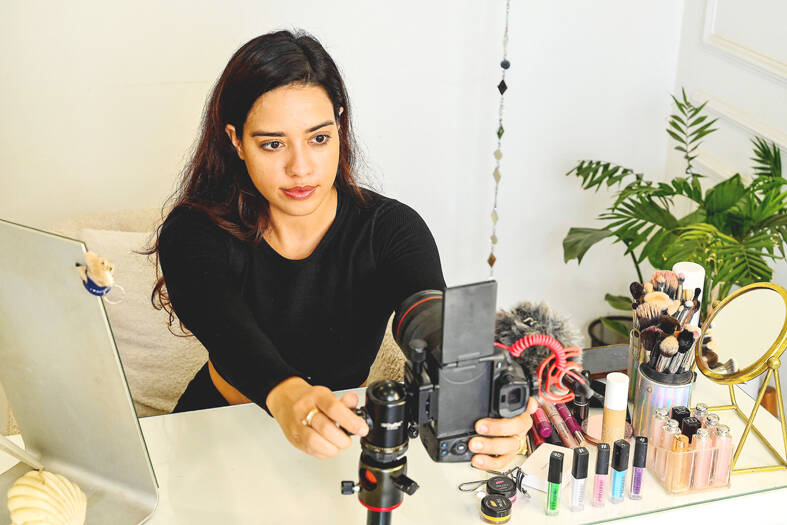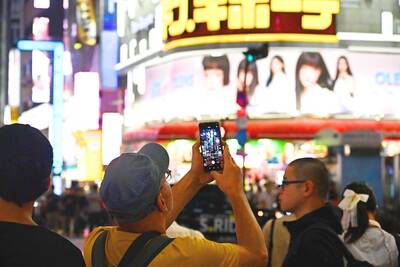Under the glow of a ring light in the spare bedroom of a Mumbai high-rise apartment, Indian makeup maven Debasree Banerjee has found fans across the world with a simple philosophy: Brown is beautiful.
Banerjee’s audience includes women from as far afield as the Middle East and US who also have a deeper complexion, but have historically been overlooked by the cosmetics industry.
“I actually have a lot of followers who are outside India, and I feel like it’s probably because our skin tones match,” Banerjee said. “They can see how the product looks like on my skin tone, how the lipstick applies on my skin tone, and just have that sense of belongingness.”

Photo: AFP
Banerjee, 34, began experimenting with makeup videos in her spare time a decade ago, after graduating from university and moving to Mumbai to work in sales.
She is now a full-time beauty and lifestyle influencer, teaching more than 500,000 followers how to beautify themselves on Instagram and YouTube.
Early inspirations included British beauty content creators Tanya Burr and Fleur de Force, both white and with millions of followers between them, but Banerjee said she had found no role models who resembled her.
She credits Rihanna for the seismic shift toward greater inclusiveness in the cosmetics industry.
In 2017, the pop superstar launched her makeup line Fenty Beauty, which offered 40 shades of foundation and turned her into a billionaire.
“Fenty Beauty really, really changed the game,” Banerjee said. “I think that’s when people knew that this is important.”
While other international brands have tried to keep up, many still have “miles and miles to go” before they can be considered truly inclusive, she added.
“I still see products being launched in three shades, in four shades, calling them ‘universal,’ and it’s just ridiculous,” Banerjee said. “In India, everywhere you go ... you see our features changing, our language changing, our skin color changing. So it’s very, very important to have more inclusive makeup.”
Cheap Internet data, rising income levels and the world’s largest population of young people have fueled an explosion in India’s beauty and personal care market.
The industry is now worth US$15 billion nationally each year, with Euromonitor saying that figure is expected to double by 2030.
Homegrown e-commerce platform Nykaa — which helped make global cosmetic brands easily available to Indians for the first time — was one of India’s most-anticipated initial public offerings in 2021.
“People thought brown skin is not pretty, but now we’ve started learning to love ourselves” said Faby, another beauty influencer living in Mumbai.
Faby has nearly 900,000 Instagram followers and has established herself as one of India’s top cosmetic stylists, recently teaming up with Bollywood actress Deepika Padukone to promote a skincare line.
Almost her entire apartment has been refashioned into a studio with professional lights, camera equipment and retractable backdrops to stylize her regular online tutorials.
The work can be taxing, with some day-long shoots lasting until well after midnight, but the money Faby makes from brand collaborations is enough to comfortably support both herself and her mother.
However, a single lipstick by a prominent international brand can cost about 2,000 rupees (US$24.38) locally — more than what half of India’s households pay for their weekly groceries, British market research firm Kantar said.
The gap between material desires and means has proven to be fertile ground for other Indian influencers showing their audiences how to keep on-trend without breaking the bank.
“There are many people who cannot afford expensive products, so my DIY shows them how to look more beautiful,” Kavita Jadon said.
From her home a couple of hours’ drive from the capital, New Delhi, the housewife and mother-of-two makes videos showing how to make ersatz concealers out of moisturiser and coffee grinds, at a fraction of the cost of name-brand products. Despite filming from a cheap phone, editing with free software, and lacking Banerjee and Faby’s elaborate studio setups, Jadon has amassed more than 169,000 followers on Facebook.
“Using products from big brands is not essential — it’s possible to use local products and create beauty products at home, too,” she said.

BRUSHED OFF: An ambassador to Australia previously said that Beijing does not see a reason to apologize for its naval exercises and military maneuvers in international areas China set off alarm bells in New Zealand when it dispatched powerful warships on unprecedented missions in the South Pacific without explanation, military documents showed. Beijing has spent years expanding its reach in the southern Pacific Ocean, courting island nations with new hospitals, freshly paved roads and generous offers of climate aid. However, these diplomatic efforts have increasingly been accompanied by more overt displays of military power. Three Chinese warships sailed the Tasman Sea between Australia and New Zealand in February, the first time such a task group had been sighted in those waters. “We have never seen vessels with this capability

A Japanese city would urge all smartphone users to limit screen time to two hours a day outside work or school under a proposed ordinance that includes no penalties. The limit — which would be recommended for all residents in Toyoake City — would not be binding and there would be no penalties incurred for higher usage, the draft ordinance showed. The proposal aims “to prevent excessive use of devices causing physical and mental health issues... including sleep problems,” Mayor Masafumi Koki said yesterday. The draft urges elementary-school students to avoid smartphones after 9pm, and junior-high students and older are advised not

Philippine President Ferdinand Marcos Jr has fired his national police chief, who gained attention for leading the separate arrests of former Philippine president Rodrigo Duterte on orders of the International Criminal Court and televangelist Apollo Carreon Quiboloy, who is on the FBI’s most-wanted list for alleged child sex trafficking. Philippine Executive Secretary Lucas Bersamin did not cite a reason for the removal of General Nicolas Torre as head of the 232,000-member national police force, a position he was appointed to by Marcos in May and which he would have held until 2027. He was replaced by another senior police general, Jose

POWER CONFLICT: The US president threatened to deploy National Guards in Baltimore. US media reports said he is also planning to station troops in Chicago US President Donald Trump on Sunday threatened to deploy National Guard troops to yet another Democratic stronghold, the Maryland city of Baltimore, as he seeks to expand his crackdown on crime and immigration. The Republican’s latest online rant about an “out of control, crime-ridden” city comes as Democratic state leaders — including Maryland Governor Wes Moore — line up to berate Trump on a high-profile political stage. Trump this month deployed the National Guard to the streets of Washington, in a widely criticized show of force the president said amounts to a federal takeover of US capital policing. The Guard began carrying